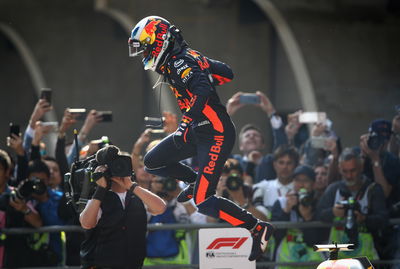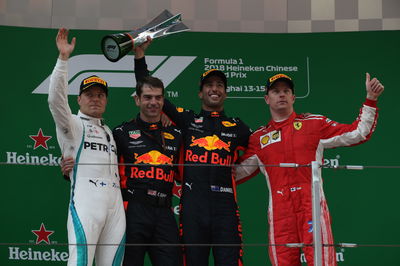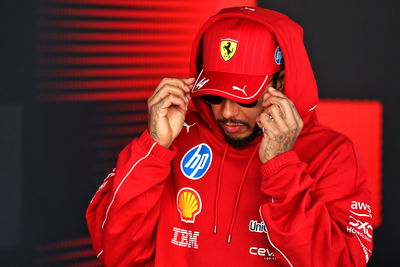F1 Race Analysis: How Ricciardo stole the Chinese GP
“Holy testicle Tuesday!”
Rarely short of a memorable quote - this one coming from Jim Carrey’s Ace Ventura - those were the words Daniel Ricciardo used to sum up his stunning Formula 1 victory in Sunday’s Chinese Grand Prix, having bounced back from almost missing qualifying to standing on the top step just 24 hours later.
It was a weekend that saw Red Bull run firmly as the third-fastest team, only for the opportunity arise for it to snatch the race away from Mercedes and Ferrari. And it was an opportunity that Ricciardo seized in clinical, cut-throat fashion.

“Holy testicle Tuesday!”
Rarely short of a memorable quote - this one coming from Jim Carrey’s Ace Ventura - those were the words Daniel Ricciardo used to sum up his stunning Formula 1 victory in Sunday’s Chinese Grand Prix, having bounced back from almost missing qualifying to standing on the top step just 24 hours later.
It was a weekend that saw Red Bull run firmly as the third-fastest team, only for the opportunity arise for it to snatch the race away from Mercedes and Ferrari. And it was an opportunity that Ricciardo seized in clinical, cut-throat fashion.
Concerns about how the Ultrasoft tyre would hold up in the race given its heavy wear in practice prompted both Ferrari and Mercedes to start on Softs, locking out the front two rows of the grid. Red Bull had no choice but to run on Ultrasofts in Q2 for fear of dropping out, and while it would give Ricciardo and Verstappen a pace advantage off the line, making a one-stop strategy work seemed to be a tall order.
Yet both drivers were able to manage their tyres and pace well. Verstappen made an excellent start to rise to third, while Ricciardo held sixth through the opening stint. The gap to Verstappen turned out to be a blessing in disguise as it allowed Red Bull to double-stack the pair in the pits, putting them on identical strategies. Nevertheless, from there, victory seemed highly, highly unlikely for Ricciardo.
The Soft tyre offered Mercedes just one more lap over the Red Bulls in managing its strategy, with Lewis Hamilton pitting at the end of Lap 18. This was partly dictated by a push to get the undercut on Kimi Raikkonen in fourth, but it triggered teammate Valtteri Bottas to make the same move on lap later, trying to get the jump on Sebastian Vettel, who from pole had been running about three seconds up the road.
Looking at Verstappen’s times on fresh Mediums, it was clear the undercut would be particularly potent. He took more than seven seconds out of Vettel at the front in just three laps. Bottas, meanwhile, did enough on his outlap to turn the three second deficit into a slender advantage, seizing the lead of the race away from Vettel.
The race seemed to be set at that point. Ferrari’s best efforts to back Bottas up into Vettel with Kimi Raikkonen - wrecking the Finn’s race in the process - proved fruitless as the Mercedes swept by, easily retaining his advantage. Barring some poor tyre management, it seemed Bottas had the race in hand.
But a tangle between Toro Rosso drivers Pierre Gasly and Brendon Hartley at the Turn 14 hairpin turned the race on its head. The clash was the result of a miscommunication: Hartley believed he would be letting Gasly by on corner exit; Gasly thought it was on entry. The tiff left debris on the track that sparked a Safety Car period, bunching the field at the front.
It was at this point Red Bull won the race, immediately bringing Verstappen and Ricciardo in with just two corners’ notice. It had been too late for Vettel or Bottas to react as they passed pit entry, yet there was still the chance for Hamilton and, in particular, Raikkonen, to react.
That was where Mercedes and Ferrari fell down. As they focused on the drivers heading the pack, they missed the opportunity to gamble with Hamilton and Raikkonen, with hindsight showing they were their only shots at now winning the race.
Hamilton was that much closer to the leaders, making a stop harder to call. But Ferrari’s decision not to pit Raikkonen was bizarre. His race had already been ruined - so why not roll the dice? He had a 24-second buffer to Nico Hulkenberg behind, meaning he would at worst lose one place by pitting. But he’d be guaranteed fresher tyres that could take him to the end of the race.
In a straight fight, you imagine Ferrari would have beaten Red Bull in China. Its pace was stronger through practice and qualifying. Track position would certainly have benefitted Verstappen and Ricciardo, yet Raikkonen would have been closely tailing them. The trio would have been a train charging through the top order.
In hindsight, it was a big blunder from Ferrari. The pace that Verstappen showed on fresh Mediums after his pit stop should have been enough to show that new tyres were the way to go. Not heeding that call cost it a possible victory.
Red Bull still had a job to do though. Verstappen and Ricciardo had to cut through the top order and hope that Bottas and Vettel did not scamper too far away in the closing stages. With 20 laps to go, it looked like it would be a close-run thing to get them to the front.
It would ultimately take just eight laps.
Ricciardo ended up stealing the show, but this really should have been Verstappen’s victory. He’d qualified higher and ran ahead in the early part of the race. His pass on Raikkonen for P4 showed the clear pace advantage the fresher tyres offered, but the immaturity of the 20-year-old - now in his fourth F1 season, remember - proved costly.
Verstappen was all over the back of Hamilton in the fight for P3, gaining significantly coming out of Turn 6. But instead of biding his time for what would have been a straightforward DRS overtake down the back straight, Verstappen went for the spectacular, trying to sling his Red Bull around the outside of Turn 7. Hamilton said after the race he’d never attempted or seen a pass there, such is its unsuitability as an overtaking spot. It’s therefore little surprise that Verstappen had to pull out of the move, take to the grass and drop back to sixth, with all his hard work to do again.
The added composure and experience of Ricciardo then shone through. His overtakes on Hamilton and, most significantly, Bottas, were sensational, somehow getting the car stopped despite braking unfathomably late.
But the one that set him apart from Verstappen was his move on Vettel. He could have tried to pass earlier, but he knew it was not worthwhile. He waited until the DRS zone before easing past. The front-runners were aware by this point there was little point in resisting the Red Bulls, as shown by Bottas’ decision not to defend at Turn 6, in fact making room for Ricciardo.
This was a race that should have been won by Bottas, could have been won by Vettel, Verstappen or Raikkonen - but was only won by Ricciardo.
It took a mix of opportunity arising and others letting it pass by. Most crucially though, Ricciardo had to seize it.
And if you give Daniel Ricciardo an inch, he will take a mile. None of his six F1 wins have come from starting inside the top three. And this was perhaps the best of the bunch.
Sky Sports F1’s Martin Brundle called Ricciardo a “race burglar” after the race. It’s hard to find a more apt description for a driver whose already-considerable stock has only risen after this stunning win.
At a time when he’s the hot property on the F1 driver market with his pick of the top three teams, Ricciardo has a great opportunity to make himself the sport’s leading name. Given his track record, don’t expect him to let it pass by.











